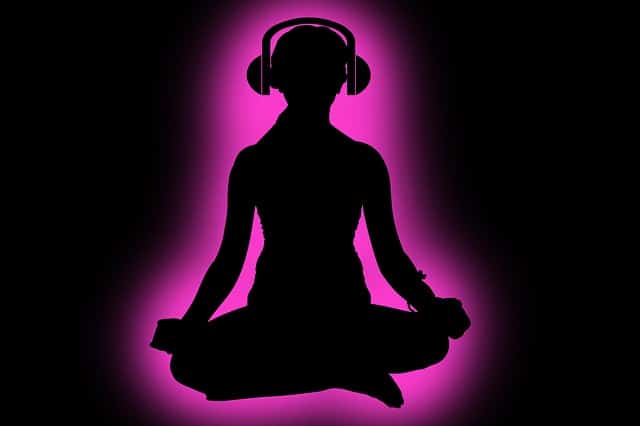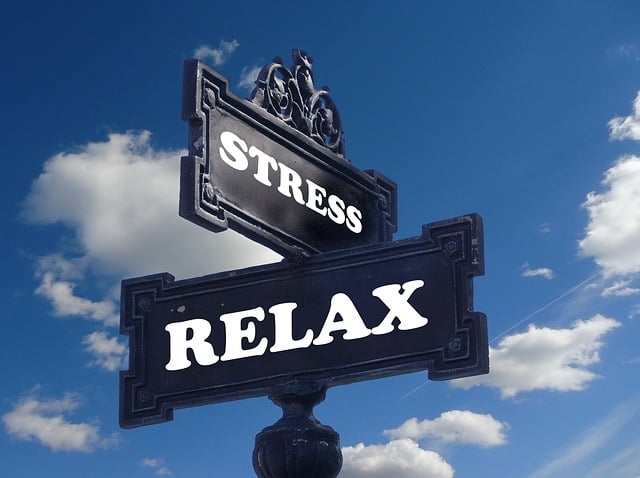Many people either starting out or advancing with mindfulness meditation wonder whether they should be doing it with headphones or earplugs on. Is this the correct way to meditate? Can doing it with headphones on bring benefits?
Meditating with headphones can be a great way of getting into the practice of mindfulness and building an “awareness muscle” which notices more quickly when the mind has wandered away from the present.
However, this kind of practice should be seen in context of a wider view of it being only an introductory starting point or stepping stone onto doing your own “free” meditation without headphones, that you yourself direct and control, once you have grasped the fundamentals of the practice well.
In addition, if the motivation of using earplugs or headphones in the first place is to block out external noises because they are too distracting, then with regular practice we find we can actually use external sounds as a very valid form of meditation, so noises are not actually seen as a distraction to the meditation, but actually become the meditation itself if we want it to.
Lets look in more detail and the benefits and advantages of using guided meditation through headphones to start, as well as the added benefits of progressing onto your own forms of meditation later on.
Meditating With Headphones is a Great Way to Start
Beginners will often find it is much easier to get into the practice of mindfulness meditation when it is guided through some kind of recording by a practitioner or expert.
It just helps when starting out to have some kind of structure to follow in terms of length and what to focus on. For people new to mindfulness, it is difficult to just immediately focus on the correct things without some kind of instruction or guidance to take you through the practice.
This is why listening to guided meditations through headphones is the way so many people start off when getting into the practice. You can also just listen freely to the recording on a device with a speaker, whilst others prefer headphones for a better sound; it’s just down to personal preference to begin with.
Another benefit of using headphones to begin with is that it can block out any low level background noise and chatter which can distract beginners just starting out. In time the whole idea of meditation is to be able to focus and tolerate or discard background distractions without being affected by them, but in the early stages having external noise can be off-putting and using headphones helps to alleviate this a little.
The bottom line here is that starting off by listening to guided meditations through headphones does work and can bring great short term benefits in greater calmness and moment to moment awareness, as well as train you in good meditation practice of noticing the wandering mind and bringing it back to a central focal point.
Meditating Without Headphones is Better Longer Term
Some Buddhists address the issue of headphones…
However, having said all this, meditating with headphones is not the way that more advanced practitioners like Buddhist monks or expert teachers tend to do it. You will never see a Buddhist in a retreat or monastery using headphones to meditate and they tend not to recommend this to others either.
See the video above for more on this. It covers the slightly different issue of whether to meditate with earplugs in to block out noise, but the information basically relates the same as to whether to listen to meditation through earphones.
Ideally, meditation in it’s purest form is meant to be something which is done more freely and spontaneously, and by acknowledging everything that is in our current environment. It is also meant to be something we control and direct once we get the hang of how to do it correctly.
Here are some example of the problems with using guided meditation through earphones, as well as the corollary benefit of meditating on your own without earphones instead.
1. Routine, schedule & length of meditation – Following guided meditations encourages us to approach meditation as a fixed routine and schedule – eg. once we have got to the end of the 10 minute recording, we stop.
Meditating freely without headphones better encourages us to go for as long as we want, varying the length of practice and carrying on as and when we feel benefits. We begin to control the practice as opposed to being directed and controlled by recordings someone else has done.
2. Approach towards meditation – Meditating through recordings can encourage us to see it as a daily chore or task we must complete. Once the recording is listened to, our chore for the day is over.
Meditating more freely encourages us to weave mindfulness more fully into our daily lives, bringing moment to moment awareness to little daily things we may have done on autopilot before, like washing dishes or some other daily task.
3. Purity of the meditation – Listening to guided recordings can bring demonstrable benefits people will notice, but still isn’t the technically correct or purest way to meditate.
The purest form of meditation is simply listening to the sounds nature creates, as well as listening to all external stimulus and not focusing only on one recording which can block out all other external things. Meditation in retreats is almost never done with headphones.
4. Sound is meditation in itself – An excellent point made in the video above. Sound is one of the five senses and therefore a valid form of meditation; some even say the best form of meditation – see the Alan Watts video below.
Rather than seeing sounds as a distraction or a nuisance, actually focus on them and make them part of the meditation. Hone in intently on the sounds you hear, the pitch, tone, echos, sounds within sounds, multiple sources of sound etc.
“People even put on these “nature sounds” on in the background because they think that’s meditation. That’s not meditation, it’s delusion, it’s putting on a show for yourself. It’s not reality. Reality is seeing, hearing, smelling, tasting, feeling and thinking”
Yuttadhammo Bhikkhu
Start Off With Guided Meditations & Move Onto Your Own
In summary then, the best progression of meditation practice is often to start off by listening to guided meditations using headphones to get into the habit of mindfulness and build up moment to moment awareness and concentration.
Listening through headphones can certainly bring great benefits and develop a strong sense of momentary awareness, as well as noticing more quickly when your mind has drifted from the present and bringing it back to the present (training the “mindfulness muscle”).
However, these introductory courses often listened to through headphones are really only an introductory step to get you started, and once you get the hang of the meditation, it is better to progress to your own free practice without using headphones and just using the five sense around you – seeing, hearing, smelling, tasting, touching – as well as thoughts, feelings, and other mind patterns.
As a caveat, if ever you feel you are getting either lazy or sloppy in your own practice, it is always a good idea to go back to some kind of structured recording to retrain yourself on the basics of paying proper attention and bringing back the wandering mind. There is no harm in doing this if you ever feel your meditation is becoming unfocused.
But meditating freely without recordings or headphones should be the aim for long term meditators. This is how meditation takes place in monasteries and other retreats, and is the formally correct way to practice according to Buddhist theory.
Regular meditators should look to get to this stage in their own time, though there is no rush and everyone can move at their own pace in terms of how they practice.






